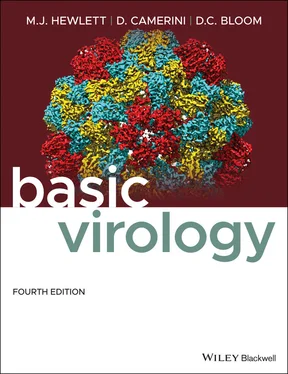In some cases, cells can mount a defense against virus infection. Most animal cells react to infection with many viruses by inducing a family of cellular proteins termed interferons that can interact with neighboring cells and induce those cells to become wholly or partially resistant to virus infection. Similarly, some viral infections of bacterial cells can result in a bacterial restrictionresponse that limits viral replication. Of course, if the response is completely effective, the virus cannot replicate. In this situation, one cannot study the infection, and in the extreme situation, the virus would not survive.
Viruses that infect multicellular organisms face problems attendant with their need to be introduced into an animal to generate a physiological response fostering the virus's ability to spread to another organism (i.e., they must exhibit virulence). This process can follow different routes.
Disease is a common result of the infection, but many (if not most) viral infections result in no measurable disease symptoms – indeed, inapparent infections are often hallmarks of highly coevolved virus–host interactions. But inapparent or asymptomaticinfections can be seen in the interaction between normally virulent viruses and a susceptible host as a result of many factors. A partial list includes the host's genetic makeup, host health, the degree of immunity to the pathogen in the host, and the random ( stochastic) nature of the infective process.
Stages of virus‐induced pathology
Pathogenesis can be divided into stages – from initial infection of the host to its eventual full or partial recovery, or its virus‐induced death. A more‐or‐less typical course of infection in a vertebrate host is schematically diagrammed in Figure 2.3. Although individual cases differ, depending on the nature of the viral pathogen and the immune capacity of the host, a general pattern of infection would be as follows:
Initial infection leads to virus replication at the site of entry, and multiplication and spread into favored tissues. The time between the initial infection and the observation of clinical symptoms of disease defines the incubation period, which can be of variable length, depending on many factors. Figure 2.3The pathogenesis of virus infection. Typically, infection is followed by an incubation period of variable length in which virus multiplies at the site of initial infection. Local and innate immunity, including the interferon response, counter infection from the earliest stages; and if these lead to clearing, disease never develops. During the incubation period, virus spreads to the target of infection (which may be the same site). The adaptive immune response becomes significant only after virus reaches high enough levels to efficiently interact with cells of the immune system; this usually requires virus attaining high levels or titers in the circulatory system. Virus replication in the target leads to symptoms of the disease in question and is often important in spread of the virus to others. Immunity reaches a maximum level only late in the infection process and remains high for a long period after resolution of the disease.
The host responds to the viral invasion by marshaling its defense forces, both local and systemic. The earliest defenses include expression of interferon and tissue inflammation. Ultimately the major component of this defense – adaptive immunity – comes into play. For disease to occur, the defenses must lag as the virus multiplies to high levels. At the same time, the virus invades favored sites of replication. Infection of these favored sites is often a major factor in the occurrence of disease symptoms and is often critical for the transmission to other organisms. As the host defenses mount, virus replication declines and there is recovery – perhaps with lasting damage and usually with immunity to a repeat infection. If an insufficient defense is mounted, the host will die.
Initial stages of infection – entry of the virus into the host
The source of the infectious virus is termed the reservoir, and virus entry into the host generally follows a specific pattern leading to its introduction at a specific site or region of the body. Epidemiologists working with human, animal, and plant diseases often use special terms to describe parts of this process. The actual means of infection between individuals is termed the vector of transmission or, more simply, the vector. This term is often used when referring to another organism, such as an arthropod, that serves as an intermediary in the spread of disease.
Many viruses must continually replicate to maintain themselves – this is especially true for viruses that are sensitive to desiccation and are spread between terrestrial organisms. For this reason, many virus reservoirs will be essentially dynamic; that is, the virus constantly must be replicating actively somewhere. In an infection with a virus with broad species specificity, the external reservoir could be a different population of animals. In some cases, the vector and the reservoir are the same – for example, in the transmission of rabies via the bite of a rabid animal. Also, some arthropod‐borne viruses can replicate in the arthropod vector as well as in their primary vertebrate reservoir. In such a case the vector serves as a secondary reservoir, and this second round of virus multiplication increases the amount of pathogen available for spread into the next host.
Some reservoirs are not entirely dynamic. For example, some algal viruses exist in high levels in many bodies of freshwater. It has been reported that levels of some viruses can approach 10 7per milliliter of seawater. Further, the only evidence for the presence of living organisms in some bodies of water in Antarctica is the presence of viruses in that water. Still, ultimately all viruses must be produced by an active infection somewhere, so in the end all reservoirs are, in some sense at least, dynamic.
Viruses (or their genomes) enter cells via the cooperative interaction between the host cell and the virus – this interaction requires a hydrated cell surface. Thus, initial virus infection and entry into the host cell must take place at locations where such cell surfaces are available, not, for example, at the desiccated surface layer of keratinized, dead epithelial cells of an animal's skin, or at the dry, waxy surface of a plant. In other words, virus must enter the organism at a site that is “wet” as a consequence of its anatomical function or must enter through a trauma‐induced break in the surface. Figure 2.4is a schematic representation of some modes of virus entry leading to human infection.
The incubation period and spread of virus through the host
Following infection, virus must be able to replicate at the site of initial infection in order for it to build up enough numbers to lead to the symptoms of disease. There are several reasons why this takes time. First, only a limited amount of virus can be introduced. This is true even with the most efficient vector. Second, cell‐based innate immune responses occur immediately upon infection. The best example of these is the interferon response.

Figure 2.4Sites of virus entry in a human. These or similar sites apply to other vertebrates.
Source: Adapted from Mims, C.A. and White, D.O. (1984). Viral Pathogenesis and Immunity . Boston: Blackwell Science.
This “early” stage or incubation period of disease can last from only a few days to many years, depending on the specific virus. In fact, probably many virus infections go no further than this first stage, with clearance occurring without any awareness of the infection at all. Also, some virus infections lead only to replication localized at the site of original entry. In such a case, extensive virus spread need not occur, although some interaction with cells of the immune system must occur if the animal host is to mount an immune response.
Читать дальше













